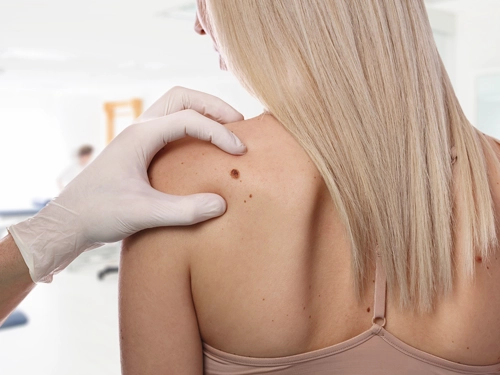Introduction Dr. Leslie Baumann, a distinguished figure in the realm of cosmetic dermatology, stands as a beacon of expertise in the pursuit of healthy and radiant skin. With numerous publications and groundbreaking research on skincare ingredients under her belt, Dr. Baumann is a trusted source for those looking to enhance their skin’s well-being. In this
Introduction
Dr. Leslie Baumann, a distinguished figure in the realm of cosmetic dermatology, stands as a beacon of expertise in the pursuit of healthy and radiant skin. With numerous publications and groundbreaking research on skincare ingredients under her belt, Dr. Baumann is a trusted source for those looking to enhance their skin’s well-being. In this comprehensive guide, we embark on a journey to demystify the process of mole removal.
Moles, often innocuous but occasionally a source of concern, can be an aspect of your skin that you wish to address. Whether it’s for cosmetic reasons or due to health considerations, mole removal is a topic that deserves careful attention and guidance from a true authority in the field. Dr. Leslie Baumann is here to provide insights, share expert advice, and guide you through the process of mole removal, ensuring that your skin remains clear, healthy, and confident.
Understanding Moles: What You Need to Know
Before we delve into the methods and considerations of mole removal, let’s gain a thorough understanding of what moles are and when they may warrant removal.
What Are Moles?
Moles, medically known as nevi, are clusters of pigmented cells that can appear anywhere on the skin’s surface. They come in various shapes, sizes, and colors and are usually harmless. While most moles pose no health risks, some may change over time or exhibit unusual characteristics, raising concerns about their potential for malignancy.
When to Consider Mole Removal
Mole removal may be considered for several reasons:
- Cosmetic Concerns: Moles that are aesthetically bothersome or impact one’s self-esteem may be candidates for removal.
- Suspicious Changes: Moles that change in color, shape, size, or texture should be evaluated by a dermatologist, as they could indicate skin cancer.
- Irritation or Discomfort: Moles that rub against clothing or become irritated may require removal for comfort.
- Family History: Individuals with a family history of skin cancer may choose to have moles removed preventatively.

Image by: https://living.aahs.org/cancer/beauty-marks-and-moles-how-to-spot-a-problem/
Mole Removal Methods
Dr. Leslie Baumann recommends several methods for mole removal, each tailored to the specific mole’s characteristics and your preferences.
Excision
Excision is a common method for removing moles. In this procedure, the mole and a margin of healthy skin are cut out and the wound is closed with sutures. It is typically used for larger moles or those suspected of being cancerous.
Shave Excision
For raised moles, shave excision is a suitable option. The mole is shaved off at skin level using a scalpel, leaving minimal scarring.
Laser Removal
Laser removal is effective for small, non-cancerous moles. It involves the use of a laser to break down the pigment in the mole, causing it to fade over time.
Cryotherapy
Cryotherapy involves freezing the mole with liquid nitrogen, causing it to blister and eventually fall off. This method is suitable for smaller moles and may require multiple sessions.
Electrocautery
Electrocautery uses an electrical current to burn off the mole tissue. It’s typically reserved for small, non-cancerous moles.
Post-Removal Care and Healing
Once a mole is removed, proper care is essential to ensure optimal healing and minimal scarring. Dr. Baumann recommends the following post-removal care:
- Keep the area clean and dry: Avoid excessive moisture and irritation.
- Protect from the sun: Use sunscreen and protective clothing to shield the healing area.
- Follow your dermatologist’s instructions: Adhere to any specific care instructions provided by your healthcare provider.
Dr. Leslie Baumann’s Expert Insights
As a leading expert in cosmetic dermatology, Dr. Baumann has invaluable insights to share when it comes to mole removal:
- “Early detection is crucial. If you notice any changes in your moles, consult a dermatologist promptly.”
- “Always prioritize your safety. If a mole appears suspicious, it’s essential to have it evaluated by a medical professional.”
- “Choose a mole removal method that aligns with the characteristics of your mole and your skin type. Consult your dermatologist for personalized recommendations.”
- “Post-removal care is just as important as the removal procedure itself. Protect your skin from the sun and follow your dermatologist’s guidance for optimal healing.”
Conclusion
In your pursuit of clear and healthy skin, mole removal can play a significant role. Thanks to the expertise of Dr. Leslie Baumann, you now have a comprehensive guide to help you make informed decisions about mole removal.
Remember, whether you seek to address cosmetic concerns or have health considerations, consulting with a dermatologist is the first step. Your skin’s well-being is worth the investment in professional care and guidance. With the right knowledge and expertise, you can achieve the clear and confident skin you desire.

















Leave a Comment
Your email address will not be published. Required fields are marked with *